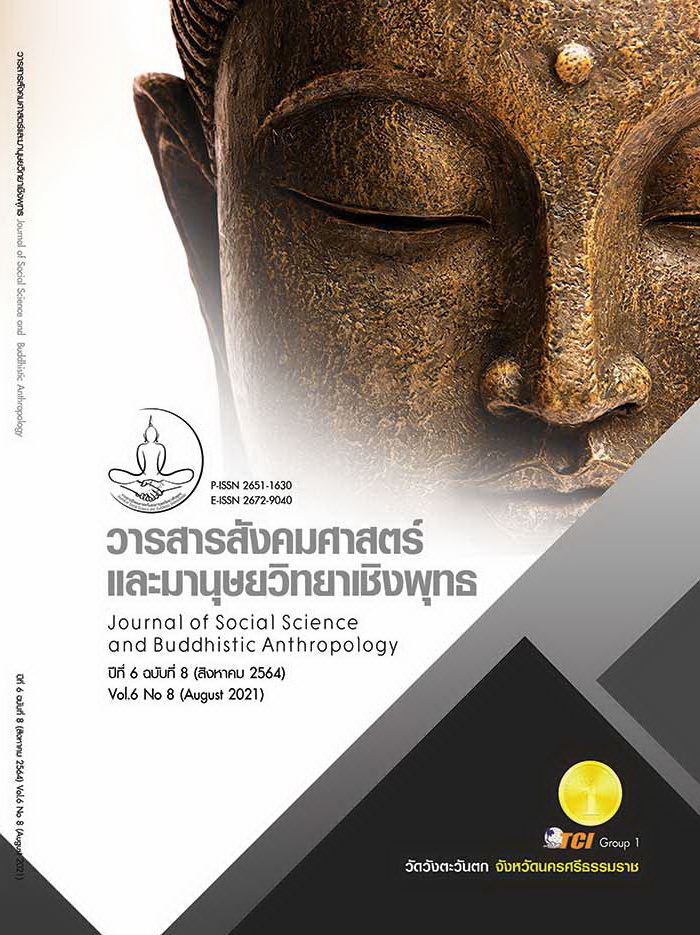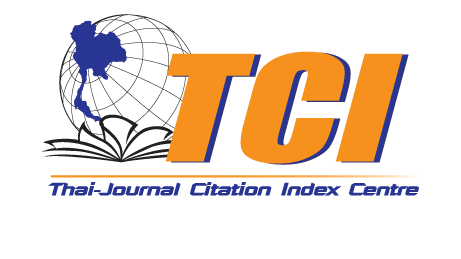แบบจำลองสมการโครงสร้างปัจจัยที่มีอิทธิพลต่อผลการดำเนินงานของกลุ่มวิสาหกิจชุมชน
คำสำคัญ:
กลุ่มวิสาหกิจชุมชน, ภาวะผู้นำเชิงเปลี่ยนแปลง, การเรียนรู้และเจริญเติบโต, กระบวนการภายใน, ผลการดำเนินงานบทคัดย่อ
บทความวิจัยนี้มีวัตถุประสงค์เพื่อวิเคราะห์แบบจำลองสมการโครงสร้างของปัจจัยที่มีอิทธิพลต่อผลการดำเนินงานของวิสาหกิจชุมชนในจังหวัดสุราษฎร์ธานีและเพื่อศึกษาแนวทาง การพัฒนากลุ่มวิสาหกิจชุมชนในจังหวัดสุราษฎร์ธานีให้มีผลการดำเนินงานที่ดีขึ้นอย่างต่อเนื่อง โดยใช้การวิจัยแบบผสมผสาน สำหรับการวิจัยเชิงปริมาณมีกลุ่มตัวอย่าง 520 ตัวอย่าง ใช้วิธีการสุ่มตัวอย่างแบบแบ่งชั้น เก็บรวบรวมข้อมูลจากประธาน รองประธาน และกรรมการของกลุ่มวิสาหกิจชุมชนโดยใช้แบบสอบถาม วิเคราะห์ข้อมูลด้วยแบบจำลองสมการโครงสร้าง ส่วนการวิจัยเชิงคุณภาพมีผู้ให้ข้อมูลสำคัญ ได้แก่ ประธาน รองประธาน และกรรมการของกลุ่มวิสาหกิจชุมชน ซึ่งใช้วิธีการเลือกแบบเจาะจง เก็บรวบรวมข้อมูลด้วยการสนทนากลุ่ม จำนวน 16 คน แบ่งเป็น 2 กลุ่ม ๆ ละ 8 คน และสัมภาษณ์เชิงลึก จำนวน 8 คน โดยใช้แบบสัมภาษณ์กึ่งโครงสร้างและวิเคราะห์ข้อมูลด้วยการวิเคราะห์เนื้อหา ผลการวิจัยพบว่า แบบจำลองที่พัฒนาขึ้นประกอบด้วยตัวแปรแฝง 4 ตัวแปร ได้แก่ ภาวะผู้นำเชิงเปลี่ยนแปลง การเรียนรู้และเจริญเติบโต กระบวนการภายใน และผลการดำเนินงาน มีความสอดคล้องกับข้อมูลเชิงประจักษ์ (X2/df = 1.980, RMSEA = 0.047, CFI = 0.990, SRMR = 0.033) สำหรับแนวทางการพัฒนากลุ่มวิสาหกิจชุมชนในจังหวัดสุราษฎร์ธานีเพื่อให้มีประสิทธิภาพในการดำเนินงานที่ดีขึ้นอย่างต่อเนื่อง ได้แก่ 1) ผู้นำของวิสาหกิจชุมชนควรมีรูปแบบภาวะผู้นำเชิงเปลี่ยนแปลง 2) ด้านการเรียนรู้และเจริญเติบโตที่เข้มแข็ง 3) ด้านกระบวนการภายในต้องมีความพร้อมในการให้บริการลูกค้าภายใต้ความรับผิดชอบต่อสังคม 4) ด้านผลการดำเนินงานที่เป็นไปตามเป้าหมาย และ 5) ด้านการดำเนินงานตามแผนที่กลยุทธ์ กลุ่มวิสาหกิจชุมชนต้องให้ความสำคัญกับมิติต่าง ๆ ในแผนที่กลยุทธ์ของวิสาหกิจชุมชน
เอกสารอ้างอิง
กองส่งเสริมวิสาหกิจชุมชน กรมส่งเสริมการเกษตร. (2563). สรุปจำนวนวิสาหกิจชุมชนและเครือข่ายวิสาหกิจชุมชนที่อนุมัติการจดทะเบียนแล้วจำแนกตามประเภทกิจการ จังหวัด สุราษฎร์ธานี. เรียกใช้เมื่อ 10 กุมภาพันธ์ 2563 จาก http://smce.doae.go.th /smce1/report/report_smce_activity.php
ปลื้มใจ ไพจิตร และชาญวิทย์ ทองโชติ. (2560). กระบวนการบริหารที่ส่งผลต่อประสิทธิผลวิสาหกิจชุมชน กลุ่มแปรรูปและผลิตอาหาร จังหวัดสุราษฎร์ธานี. วาสารวิทยาการจัดการ, 4(2), 175 - 204.
ไพศาล มุ่งสมัคร และคณะ. (2556). รูปแบบการจัดการที่ประสบผลสำเร็จของกลุ่มเครือข่ายวิสาหกิจชุมชน ผลิตภัณฑ์สมุนไพร กลุ่มจังหวัดนครชัยบุรินทร. วารสารสมาคมนักวิจัย, 18(3), 115 - 123.
สำนักงานคณะกรรมการพัฒนาเศรษฐกิจและสังคมแห่งชาติ. (2559). แผนพัฒนาเศรษฐกิจและสังคมแห่งชาติ ฉบับที่ 12 พ.ศ. 2560 - 2564. เรียกใช้เมื่อ 1 ธันวาคม 2562 จาก http://planning.dld.go.th/th/images/stories/section-5/2561/strategy03.pdf
สำนักงานส่งเสริมวิสาหกิจขนาดกลางและขนาดย่อม. (2563). รายงานสถานการณ์วิสาหกิจขนาดกลางและขนาดย่อม. เรียกใช้เมื่อ 22 ตุลาคม 2563 จาก https://www.sme.go.th /upload/mod_download/download-20200824164414.pdf
Arasti, R. et al. (2012). Exploring the Effect of Individual Factors on Business Failure in Iranian New Established Small Businesses. International Business Research, 5(4), 2-11.
Arif, S. & Akram, A. (2018). Transformational Leadership and Organizational Performance. SEISENSE Journal of Management, 1(3), 59 - 75.
Atan, J. & Mahmood, N. H. N. (2019). The role of transformational leadership style in enhancing employees’ competency for organization performance. Management Science Letters, 9(1), 2191 - 2200.
Athukorala, C. et al. (2016). The impact of transformational and transactional leadership styles on knowledge creation in Sri Lankan software industry. Retrieved February 10, 2020, from http://dl.lib.uom.lk/handle/123/11796
Benzing, C. et al. (2009). Entrepreneurs in Turkey: A Factor Analysis of Motivations, Success Factors, and Problems. Journal of Small Business Management, 47(1), 58-91.
Gray, D. et al. (2012). Success in challenging times: Key lessons for UK SMEs - Summary Report. Retrieved February 10, 2020, from https://www. researchgate.net/publication/237076800_Success_in_challenging_times_Key_lessons_for_UK_SMEs_-_Summary_Report
Kader, R. A. et al. (2009). Success factors for small rural entrepreneurs under the one-district-one-industry programme in Malaysia. Contemporary Management Research, 5(2), 147-162.
Kaplan, D. (2000). Structural Equation Modeling. CA: Sage Publications.
Kaplan, R. S. & Norton, D. P. (2004). The strategy map: guide to aligning intangible assets. Strategy & Leadership, 32(5), 10-17.
Kasim, T. et al. (2018). The Improvement of Business Efficiency Through Business Process Management. Journal of Economics and Business, 16(1), 31 - 43.
Kline, R. B. (2011). Principles and practice of structural equation modeling. (3rd ed.). NY: The Guilford Press.
Kumar, V. & Sharma, R. R. K. (2018). Leadership styles and their relationship with TQM focus for Indian firms: An empirical investigation. International Journal of Productivity and Performance Management, 67(6), 1063-1088.
Lucianetti, L. (2010). The impact of the strategy maps on balanced scorecard performance. International Journal of Business Performance Management, 12(1), 21-36.
Lussier, R. N. & Halabi C. E. (2010). Three-Country Comparison of the Business Success versus Failure Prediction Model. Journal of Small Business Management, 48(3), 360-377.
Mittal, S. & Dhar, R. L. (2015). Transformational leadership and employee creativity: mediating role of creative self-efficacy and moderating role of knowledge sharing. Management Decision, 53(5), 894-910.
Nielsen, S. & Nielsen, E. H. (2015). The Balanced Scorecard and the Strategic Learning Process: A System Dynamics Modeling Approach. Advances in Decision Sciences, 1(1), 1 - 20.
Niven, P. R. (2003). Balanced scorecard step-by-step for government and nonprofit agencies. NJ: John Wiley & Sons, Inc.
Pasban, M. & Nojedeh, S. H. (2016). A Review of the Role of Human Capital in the Organization. Social and Behavioral Sciences, 230(1), 249 - 253.
Rad, A. A. (2016). Construction Industry: A Review of Transformational and Transactional Leadership and Multifactor Leadership Questionnaire. International Journal of Innovative Research in Science, Engineering and Technology, 5(12), 20268 - 20272.
Schumacker, R. E. & Lomax, R. G. (2010). A beginner’s guide to structural equation modeling. (3rd ed.). NJ: Lawrence Erlbaum Associates.
Simpson, M. et al. (2012). Towards a new model of success and performance in SMEs. International Journal of Entrepreneurial Behaviour and Research, 18(3), 264-285.
Su, F. et al. (2019). Multilevel Impacts of Transformational Leadership on Service Quality: Evidence from China. Front. Psychol, 10(1252), 1 - 11.
Sujová, A. & Marcineková, K. (2015). Improvement of Business Processes – a Research Study in Wood - a processing Companies of Slovak. Procedia Economics and Finance, 34(1), 296 - 302.
Vázquez, D. G. et al. (2019). Corporate Social Responsibility and Intellectual Capital: Sources of Competitiveness and Legitimacy in Organizations Management Practices. Sustainability, 11(5843), 1 - 28.
Wali, A. F. (2013). Information Technology Infrastructure and Customer Service Delivery. British Journal of Marketing Studies, 1(2), 17-32.
Wiersma, W. & Jurs, S. G. (2009). Research Methods in Education an Introduction. (9th ed.). MA: Pearson Education Inc.
Zhang, Y. et al. (2018). How Does Transformational Leadership Promote Innovation in Construction? The Mediating Role of Innovation Climate and the Multilevel Moderation Role of Project Requirements. Sustainability, 10(1506), 1 - 19.








